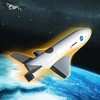Mon, 19 Apr '10
New Unmanned Spacecraft Set To Launch
Air Force officials are scheduled to launch the US's newest and most advanced unmanned re-entry spacecraft April 21 at Cape Canaveral Air Station, Fl. The X-37B Orbital Test Vehicle will provide a flexible space test platform to conduct various experiments and allow satellite sensors, subsystems, components and associated technology to be efficiently transported to and from the space environment where it will need to function.
The X-37B will also prove new technology and components before they are committed to operational satellites. The OTV is the first vehicle since NASA's shuttle orbiter that has the ability to return experiments to Earth for further inspection and analysis.
"The X-37B is the only self contained effort intended to be an economically viable experimental test platform on-orbit for months at a time and then return," said David Hamilton Jr., the Air Force Rapid Capabilities office director. Mr. Hamilton explained the X-37B as a risk reduction vehicle for space experimentation that explores concepts of operation for a long-duration, reusable space vehicle.
"The OTV has the potential to revolutionize how the Air Force operates in space by making space operations more aircraft like and adding in the capability for returnable plug-and-play experiments," Mr. Hamilton added. The X-37 program, while originally a NASA initiative, is now led by Air Force Rapid Capabilities Office officials, which expedite development and fielding of select Defense Department combat support and weapons systems. AFRCO officials are currently working on the X-37B program, building upon early development and testing conducted by officials from NASA, the Defense Advanced Research Projects Agency and the Air Force Research Laboratory.
The X-37B's first flights will allow Air Force officials to evaluate the vehicle's performance and ensure the components and systems work the way they were designed.
"There is much to learn in the first few flights on the technologies used on this vehicle, how quickly it can be readied for a re-flight, and on the operational utility," Mr. Hamilton said. "We have started discussions with Air Force Space Command (officials) to plan for the possibility for transition to an operational capability, but the system first must prove its utility and cost effectiveness during the test program."
The X-37B has a 270-day on-orbit capability and will be used to test technologies including advanced guidance, navigation and control, thermal protection systems, avionics and high temperature structures and seals. Once the testing is complete, the OTV de-orbits and lands autonomously.


READ MORE: Aero-News



 Desert Falcon's Archives
Desert Falcon's Archives





